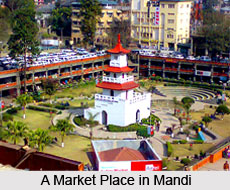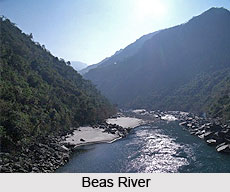 History of Mandi is relayed through the legend of the great learned sage, Mandavya Rishi. The name of the place Mandi has also been derived from the name of this sage. The name of the place was earlier Mandav Nagar and then corrupted into Mandi. The interpretation that the town got the name as it was a market place the Hindi equivalent of which is mandi appears an after-thought. The town finds its earliest mention in the inscription at the Triloknath temple, in old Mandi. The Tibetans call Mandi as Zohar and there is a story behind it.
History of Mandi is relayed through the legend of the great learned sage, Mandavya Rishi. The name of the place Mandi has also been derived from the name of this sage. The name of the place was earlier Mandav Nagar and then corrupted into Mandi. The interpretation that the town got the name as it was a market place the Hindi equivalent of which is mandi appears an after-thought. The town finds its earliest mention in the inscription at the Triloknath temple, in old Mandi. The Tibetans call Mandi as Zohar and there is a story behind it.
The great Buddhist teacher, Padma Sambhava (A.D. 750-800), went from Mandi or Zohar to Tibet at the request of the Tibetan King Sronglde Btzan to preach the doctrine of Tantric Buddhism. It is believed that many religious scriptures were taken into Tibet from Zohar (Mandi); and during the reign of Lang-darma (A.D. 900), the Tibetan King who prosecuted the Buddhists, many books are said to have been brought back to Zohar (Mandi). The Tibetans believe somewhere in Mandi or Zohar hundreds of the scriptures are lying concealed.
Legend of Mandi
Mandavya Rishi a great saint with significant supernatural powers and deep knowledge of the scriptures resided in a hermitage. There he meditated on a rock named as Kolsra, situated on the left bank of the Beas River at Mandi. In the olden days, it used to be on the right bank but the course of the river had changed.
 According to legend once the sage was in deep meditation when the King`s Policemen while tracing a band of thieves came to Mandavya Rishi`s hermitage. The saint was enquired if he knew about the robbers but as he was in meditation he did reply. The robbers had actually taken shelter in the hermitage after concealing the stolen treasure.
According to legend once the sage was in deep meditation when the King`s Policemen while tracing a band of thieves came to Mandavya Rishi`s hermitage. The saint was enquired if he knew about the robbers but as he was in meditation he did reply. The robbers had actually taken shelter in the hermitage after concealing the stolen treasure.
The Police Chief was mightily annoyed as he thought that Mandavya was posing to be a saint. They searched and discovered the booty. Immediately the matter was reported to the king who without enquiring ordered that Mandavya be put on a Shool which is a sharp-pointed planted iron shaft which would immediately pierce a man through.
Mandavya was still in a meditation trance and though put on the Shool it did not pierce him through. He was kept hanging for days while he was continuing in his meditation. When the neighbouring rishis heard of this they reported the matter to the king. The king amazed at the incident begged pardon from the saint and immediately set him at liberty.
The sage pardoned the king but approached the "Dharma Raja" as to why he was given this punishment. The Dharma Raja told that as he tortured animals when he was a child he had to undergo the punishment. Mandavya Rishi thought the punishment was too severe and cursed Dharma Raja to take birth as a man as the perpetrator of uneven justice. Mandavya Rishi was spiritually so high that his curse was implemented.



















